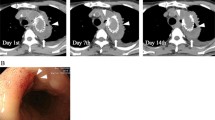Abstract
Aorto-esophageal fistula (AEF) is a rare but devastating complication of thoracic aorta endovascular repair (TEVAR). We report a case of a 64-year-old male who presented with chest pain and high CRP levels 10 months after TEVAR for a 9 cm diameter descending thoracic aortic aneurysm. The diagnosis of an AEF was confirmed and the patient was treated conservatively with broad spectrum antibiotics and total parental alimentation. After control of sepsis was achieved, esophagectomy with gastric tube reconstruction was performed and an omental pedicle was used to cover the aortic wall. No intervention to the aorta was made at that time due to the potentially infected mediastinum. The patient’s recovery was uneventful and 2 years postoperatively he is in good condition and lives a normal life. Esophagectomy seems to be a mandatory stage of treatment in the setting of AEF. In cases where signs of graft infection are persistent, aortic surgery might be also necessary.


Similar content being viewed by others
References
Amin S, Luketich J, Wald A. Aortoesophageal fistula: case report and review of the literature. Dig Dis Sci. 1998;43:1665–71.
Assik J, Vierhout B, Snellen J, Benner P, Paul MA, Cuesta MA, Wisselink W. Emergency endovascular repair of an aortoesophageal fistula caused by a foreign body. J Endovasc Ther. 2005;12:129–33.
Eggebrecht H, Mehta HR, Dechene A, Tsagakis K, Kühl H, Huptas S, Gerken G, Jakob GH, Erbel R. Aortoesophageal fistula after thoracic aortic stent-graft placemen: a rare but catastrophic complication of a novel emerging technique. JACC. 2009;2(6):570–6.
Chiesa R, Melissano G, Marone EM, Marrocco-Trischitta MM, Kahlberg A. Aorto-oesophageal and aortobronchial fistula following thoracic endovascular aortic repair: a national survey. Eur J Vasc Endovasc Surg. 2010;39:273–9.
Kawamoto S, Saiki Y, Oda K, Nitta Y, Akasaka J, Miyazaki S, et al. Successful management of esophagoparaprosthetic fistula after aortic surgery. Ann Thorac Surg. 2008;85:1449–51.
Robbs JV, Bhoola KD. Aorto-oesophageal fistula complicating tuberculous aortitis (case report). S Afr Med J. 1976;50:702–4.
Pipinos II, Reddy DJ. Secondary aortoesophageal fistula. J Vasc Surg. 1997;26:144–9.
Jonker FHW, Heijmen R, Trimarchi S, Verhagen HJM, Moll FL, Muhs BF. Acute management of aortobronchial and aortoesophageal fistulas using thoracic endovascular aortic repair. J Vasc Surg. 2009;50:999–1005.
Ghosh SK, Rahman FZ, Bown S, Harris P, Fong K, Langmead L. Survival following treatment of aortoesophageal fistula with dual esophageal and aortic intervention. Case Rep Gastroenterol. 2011;5:40–4.
Brinster CJ, Singhal S, Lee L, Marshall MB, Kaiser LR, Kucharczuk JC. Evolving options in the management of esophageal perforation. Ann Thorac Surg. 2004;77(4):1475.
Chiesa R, Tshomba Y, Kahlberg A, Marone EM, Civilini E, Coppi G, Psacharopulo D, Melissano G. Management of thoracic endograft infection. J Cardiovasc Surg (Torino). 2010;51(1):15–31.
Czerny M, Zimpfer D, Fleck T, et al. Successful treatment of an aortoesophageal fistula after emergency endovascular thoracic aortic stent-graft placement. Ann Thorac Surg. 2005;80:1117–20.
Prokakis C, Koletsis E, Apostolakis E, Dedeilias P, Dougenis D. Aortoesophageal fistulas due to thoracic aorta aneurysm: surgical versus endovascular repair. Is there a role for combined aortic management? Med Sci Monit. 2008;14(4):48–54.
Imoto Y, Sese A, Sakamoto M, Ochiai Y, Noshiro H, Uchiyama A. One-stage operation for esophageal perforation of a thoracic aortic aneurysm. Gen Thorac Cardiovasc Surg. 2012;60:56–9.
Kitayama J, Morota T, Kaisaki S, et al. Complete coverage of in situ aortograft by total omental pedicle flap as the most reliable treatment of aortoesophageal fistula. Am J Surg. 2006;192:130–4.
Conflict of interest
The author(s) declare that they have no competing interests.
Author information
Authors and Affiliations
Corresponding author
Rights and permissions
About this article
Cite this article
Georvasili, V.K., Bali, C., Peroulis, M. et al. Management of an aorto-esophageal fistula, complicating a descending thoracic aortic aneurysm endovascularly repaired. Gen Thorac Cardiovasc Surg 64, 216–219 (2016). https://doi.org/10.1007/s11748-014-0421-y
Received:
Accepted:
Published:
Issue Date:
DOI: https://doi.org/10.1007/s11748-014-0421-y




